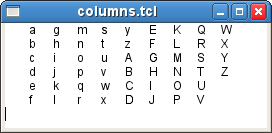Version 8 of Multi-column display in text widget
Updated 2010-01-28 23:14:08 by WJGPeter Berger wrote:
> I have been charged with the task of presenting data. I recieve a list in
> alphabetical order such as: a b c d e f g h i j, and need to present it in a
> dialog and organized in rows or columns such as:
> a e i
> b f j
> c g
> d h
> If the dialog expands the number of columns should increase. Currently I
> use this code:
>
> pack [text .text -wrap word -tabs "1.25i left" -setgrid 0]
> set alist "apple bear cow dear elephant fine grape hello idol"
> foreach a $alist {.text insert end "$a\t"}
>
> but this orginizes data as:
> a b c
> d e ...
> Anyone have any ideas on how I can switch to the other format?KBK replies (20 Feb 2001):
Are you really trying, instead, to do a multi-column listbox? If so, then Bwidget and Tix both have them, and you should probably just pick up one of them. (DKF: In Tk 8.5 or Tile, you can also use the ttk::treeview widget.)
If you really need multi-column display in a text widget, read on...
I started to code this, and it turned out to be more interesting than I thought. I assume that you don't know the height of the text in advance, so you have to bind to the <Configure> event and adjust your columns on the fly. The code I came up with is shown below. Check out what happens when you resize the window.
# Schedule to lay out the columns of the text from the idle loop
proc repackWhenIdle { w args } {
variable repackPending
if { ! [info exists repackPending($w)] } {
set repackPending($w) {}
after idle [list [namespace code repack] $w]
}
return
}
# Lay out the columns of the text.
proc repack { w } {
variable repackPending
variable list
# Reset the flag that keeps this from being repeat-scheduled.
catch { [unset repackPending($w)] }
# Clear the old content of the widget
$w configure -state normal
$w delete 1.0 end
# Calculate number of lines to display
set lineHeight [font metrics [$w cget -font] -linespace]
set textHeight [expr { [winfo height $w] - 2 * [$w cget -borderwidth] }]
set numLines [expr { int( $textHeight / $lineHeight ) }]
# Bail out if the widget is too small to display anything
if { $numLines < 1 } {
return
}
# Insert the requisite number of newlines, plus one
for { set i 0 } { $i < $numLines } { incr i } {
$w insert end \n {}
}
# Build up the list, in columns
set line 1
set sep {}
foreach item $list {
incr line
$w insert "${line}.0-1c" $sep {} $item {}
if { $line > $numLines } {
set line 1
set sep "\t"
}
}
# Delete the excess newline
$w delete end-1l end
$w configure -state disabled
return
}
# Set up the text
grid [text .t \
-state disabled \
-wrap none \
-font {Helvetica 12} \
-width 40 -height 7 \
-tabs {1.25i left} ] \
-sticky nsew
grid rowconfigure . 0 -weight 1
grid columnconfigure . 0 -weight 1
# Arrange to repack the text when either the text geometry or the
# list content changes
trace variable list w [list repackWhenIdle .t]
bind .t <Configure> [list repackWhenIdle %W]
# Set initial content of the list
set list {
apple blackberry blueberry cherry grape grapefruit kiwi kumquat
lemon nectarine orange peach pear plum prune
raisin raspberry strawberry tangerine
}WJG (28/Jan/10) This is a simple solution that I came up with. With a little adjustment it could be adapted to become a stand-alone proc.
#!/bin/sh
# the next line restarts using tclsh \
exec tclsh "$0" "$@"
#---------------
package require Gnocl
set txt1 [gnocl::text]
gnocl::window -child $txt1 -defaultWidth 320 -defaultHeight 200
set data {a b c d e f g h i j k l m n o p q r s t u v w x y z
A B C D E F G H I J K L M N O P Q R S T U V W X Y Z}
set rows(max) 6
set r 0 ;# row counter
# initialise array to hold output strings
for {set i 0 } {$i < $rows(max) } {incr i} { set rows($i) {} }
# build up the output strings
for {set i 0} {$i < [llength $data] } {incr i} {
set rows($r) "$rows($r)\t[lindex $data $i]"
incr r
if {$r == $rows(max) } {set r 0}
}
# insert int the text
for {set i 0 } {$i < $rows(max) } {incr i} {
$txt1 insert end $rows($i)\n
}And this is what it produces:
